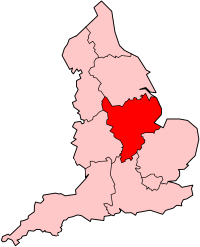Nottingham–Grantham line
The Nottingham–Grantham line is a branch line between the city of Nottingham and the town of Grantham in the East Midlands of England. For most of its length it runs parallel to the A52.
| Nottingham–Grantham line | |
|---|---|
 A class 158 nearing Radcliffe station | |
| Overview | |
| Type | Heavy rail |
| System | National Rail |
| Status | Operational |
| Locale | Lincolnshire Nottinghamshire East Midlands |
| Termini | Nottingham 52.9471°N 1.1467°W Grantham 52.9067°N 0.6430°W |
| Stations | 8 |
| Operation | |
| Opened | 1850 |
| Owner | Network Rail |
| Operator(s) | East Midlands Railway |
| Rolling stock | |
| Technical | |
| Number of tracks | Two |
| Track gauge | 4 ft 8 1⁄2 in (1,435 mm) standard gauge |
| Nottingham to Grantham Line | |||||||||||||||||||||||||||||||||||||||||||||||||||||||||||||||||||||||||||||||||||||||||||||||||||||||||||||||||||||||||||||||||||||||||||
|---|---|---|---|---|---|---|---|---|---|---|---|---|---|---|---|---|---|---|---|---|---|---|---|---|---|---|---|---|---|---|---|---|---|---|---|---|---|---|---|---|---|---|---|---|---|---|---|---|---|---|---|---|---|---|---|---|---|---|---|---|---|---|---|---|---|---|---|---|---|---|---|---|---|---|---|---|---|---|---|---|---|---|---|---|---|---|---|---|---|---|---|---|---|---|---|---|---|---|---|---|---|---|---|---|---|---|---|---|---|---|---|---|---|---|---|---|---|---|---|---|---|---|---|---|---|---|---|---|---|---|---|---|---|---|---|---|---|---|---|
| |||||||||||||||||||||||||||||||||||||||||||||||||||||||||||||||||||||||||||||||||||||||||||||||||||||||||||||||||||||||||||||||||||||||||||
The following places are served by the line.
Routes to Skegness
At Grantham, the line meets the East Coast Main Line and also the Grantham–Skegness line. Not all Skegness-bound trains stop at Grantham, and the express service (limited stop) has its first stop at Sleaford, splitting from the Grantham line near Allington onto the Grantham Avoiding Line at Allington junction.[1] The journey on this route to Skegness saves 30 minutes of the 2 hours 20 minutes journey via Grantham.
History
The line was initially operated by the Ambergate, Nottingham, Boston and Eastern Junction Railway from 15 July 1850, taken over by the GNR in 1852. At Bottesford, the line was crossed by a north-south LNWR line from Melton Mowbray to Newark-on-Trent (this northern section was owned by GNR). A western spur of this railway (through Barnstone) joined at Saxondale junction.[2]
Services were disrupted in July 2012 when an embankment collapsed near Allington.[3][4] The line also closed for some six weeks in the summer of 2013, as part of a large-scale improvement to Nottinghamshire's rail network.[5] Skegness councillors were critical of the decision to close the line during the height of the tourist season, but Network Rail, the rail infrastructure company, stated that the summer was the quietest time on the line.[6]
Cotgrave Colliery branch
The branch to Cotgrave Colliery left the Grantham line at the east end of the viaduct over the River Trent and headed south for about 2 miles (3.2 km). It was built in 1960. The major engineering work was the 360 yards (330 m) long, 30 feet (9.1 m) high, concrete viaduct,[7] formed of 37 spans of about 30 feet (9.1 m) each, where the branch left the main line. Most of the line was on a bank about 21 feet (6.4 m) high, formed of about 300,000 cubic yards (230,000 m3) of fill from a borrow pit alongside the main road. Most of the line was on a 1 in 392 gradient, with 1,030 yards (940 m) at 1 in 199.[8] The colliery closed in 1993 and the track was lifted in 2012.[7]
Services
All services along the line are provided by East Midlands Railway, mainly an hourly service in each direction between Liverpool Lime Street and Norwich, calling only at Nottingham and Grantham; and an hourly service each direction between Nottingham and Skegness, via Grantham, calling at most stations. Very few trains serve Netherfield, Radcliffe or Elton and Orston. The Liverpool-Norwich service is usually formed of Class 158 Express Sprinter diesel multiple units (DMUs), the Skegness service is usually formed of Class 156 Super Sprinter DMUs, occasionally supplemented by Class 153 Super Sprinter DMUs.
On very busy summer services to Skegness, East Midlands Railway will use a Class 43 with a set of Mark 3 coaches. These would usually be used on services to London from Sheffield, Derby and Nottingham that run express.
References
- "Allington Junction". Signalbox.org. Retrieved 21 July 2012
- "The Barnstone Branch" Archived 17 March 2007 at the Wayback Machine. Steamrailways.com. Retrieved 21 July 2012
- "Bank slip in Lincolnshire affects train services". BBC News. BBC. 20 July 2012. Retrieved 20 July 2012.
- "Grantham and Nottingham rail services resume after bank slip work". BBC News. BBC. 22 July 2012. Retrieved 22 July 2012.
- "Nottingham to London trains affected by £100m works". BBC News. BBC. 19 July 2012. Retrieved 21 July 2012.
- "Skegness tourists put off by work at Nottingham station". BBC News. BBC. 23 July 2012. Retrieved 24 July 2012.
- Cotgrave Viaduct photo and article
- Railway Magazine May 1960 p. 353. 'Colliery Branch Construction in Nottinghamshire'
External links
- "Binghams Railways". Bingham Heritage Trails Association. Retrieved 21 July 2012
| Wikimedia Commons has media related to Nottingham to Grantham Line. |
